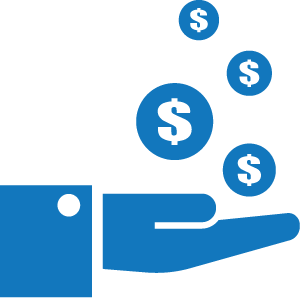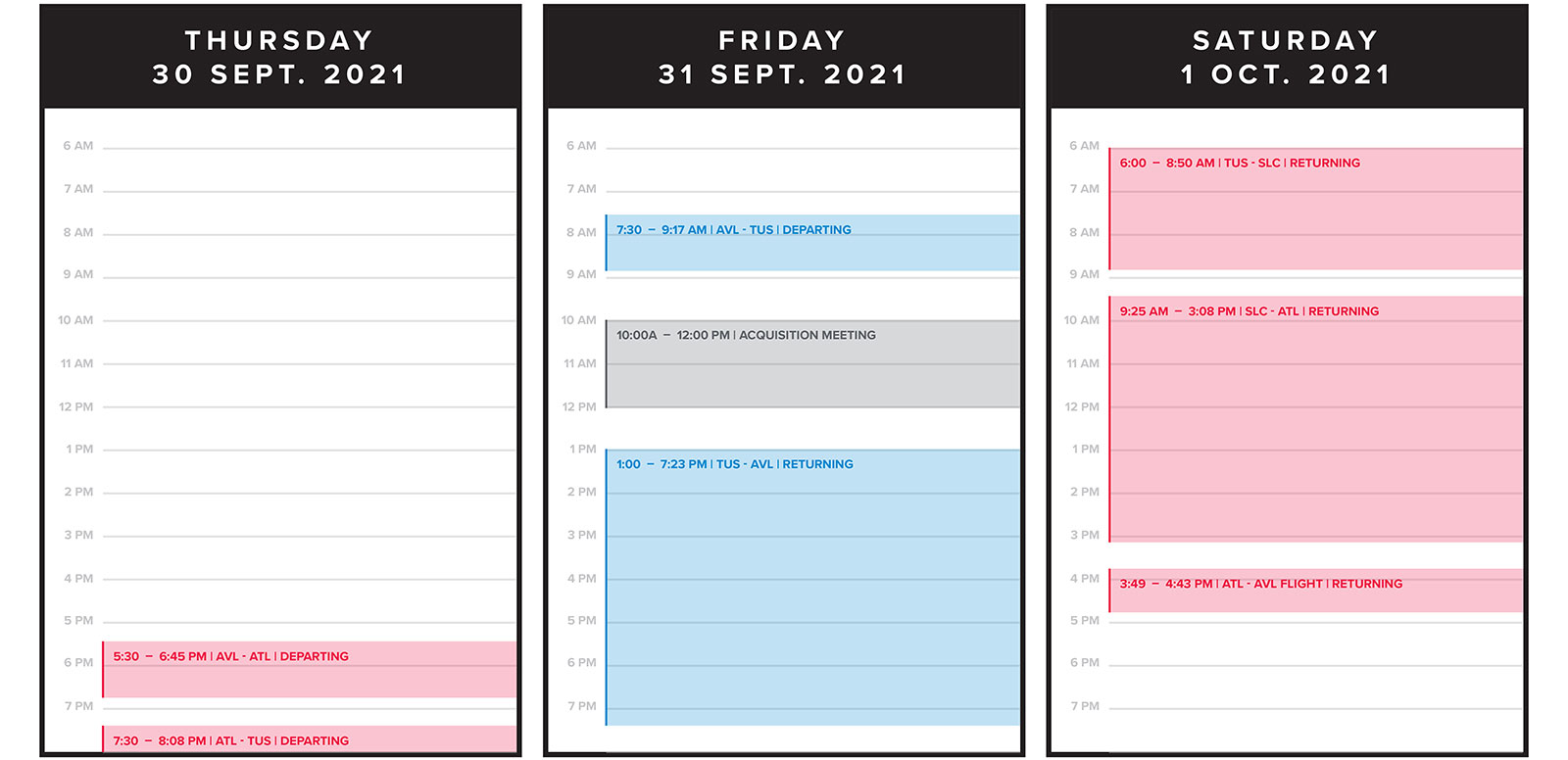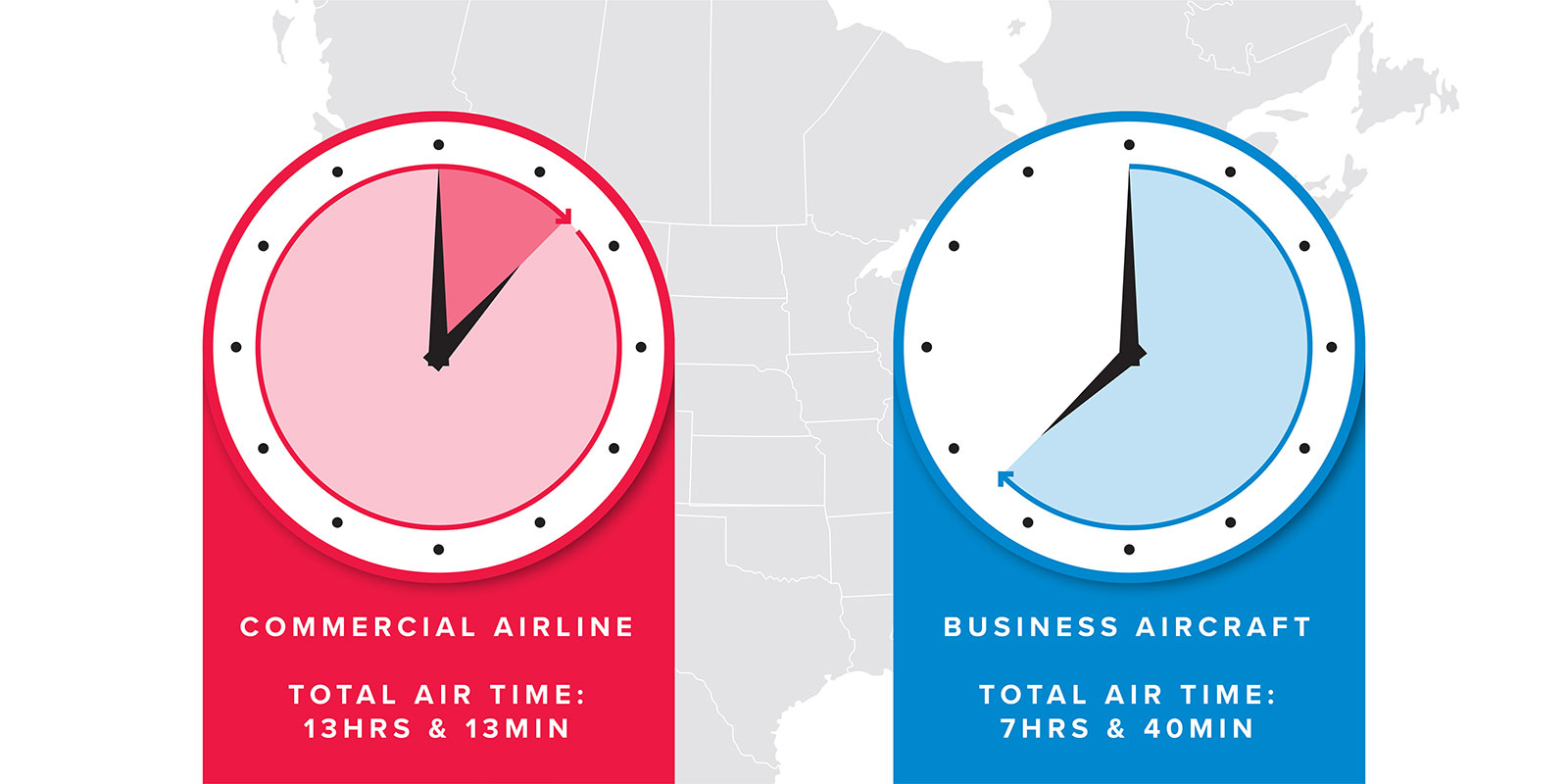↩ Back
BUSINESS AIRCRAFT OR COMMERCIAL AIRLINES?
THE ANSWER IS YOUR VALUE OF TIME
When the distance is too far to drive to attend a conference or to meet your customer, it’s time to decide whether to travel by airline or business aircraft. Companies that consider both options look at the question from all sides and then choose based on the answer that saves time, money or both.
What should you consider?
Industry comparison models show several factors affect overall travel cost, including how many people are traveling, the average wages of those traveling, the prices of airline tickets, hotel costs, rental car rates and meal reimbursements. Also, when you need to travel makes a difference, too. Two weeks’ notice to the airlines reduces airfares but planning a trip at the end of the week could cost $1,000 or more per person in airline tickets alone. Business aircraft offer convenience and flexibility – you fly when the opportunities arise.

Hard costs
- Airline ticket
- Hotel
- Rental Car
- Meals

Indirect costs
- Lengthy waits at the airport
- Travel time to reach your final destination
- Lost productivity of top earners
- Extra days on the road due to distance
The models show indirect costs from airline travel can add up quickly, too. For the most part, those employees traveling are doing so because they are high performers. When you consider the business pays the travelers per hour of work, it costs the company for those high-performing travelers to sit in airports, mitigate delays and spend extra time on the road. All time that could be spent adding value to the company. That’s not to mention extra dollars for lodging, rental vehicles and meals that span three days when they could in fact span one.
Consider the example below regarding a business located in downtown Asheville, N.C. The company intends to send a group of executives to Tucson, Ariz. to pitch a major acquisition at 10:00 a.m. (Tucson time) on a Friday. It’s the type of meeting the executives need to be sharp for and you’re exploring travel options.
Let's start with the obvious: getting to the airport. The closest airport to Asheville is the Asheville Regional Airport in Fletcher, N.C. which is roughly 15 miles away from downtown and anywhere from a 20-30-minute drive, depending on traffic.
If going by airline, there is nothing direct from the Asheville Regional Airport to Tucson, Ariz. so you’ll have to connect. Looking at Google Flights, the arriving choice that takes the least amount of time is 5 hours and 30 minutes total. Given the 10:00 a.m. meeting time in Tucson, Ariz., the executives should probably get to Tucson the night before to be fresh and ready for the meeting. One night of rest and a full day of travel the next day, accounting for the time change gets the executives to their home airport just before dinner time. That same 20-30 min commute means the executives lost half of their weekend and likely some time Thursday working as well.
If you’ve traveled commercially before, you likely know those connection times are a bit tight, especially for airports as large as Atlanta and Salt Lake City. If the unfortunate situation would occur that the executives missed a connection, you’d have to consider not only time added, but the potential for missing such an important meeting.
But what if those connections and hotels weren’t necessary? What if that company had the means to fly direct from Asheville Regional Airport to Tucson International Airport and back in the same day? On top of that, those executives would be home for a late dinner the same morning they left. With the CITATION LATITUDE jet, it's possible.
Consider the difference in commercial air (shown in red) and private air (shown in blue) to accomplish the trip.

When going by airline, it often takes an entire day of travel just to get to the destination. Business aircraft offer far more efficiency because according to the National Business Aviation Association in 2021, you can reach 10 times the number of airfields with private aviation than you can with commercial airlines. That brings passengers closer to their colleagues, customers, and facilities and in much less time. Textron Aviation customers use that to their business advantage.
We're able to go to where the work is as opposed to trying to make work where we are.John DiMarco, DiMarco Group President & COO

For instance, leaders of the DiMarco Group who operate out of the northeastern part of the United States operate a Citation Latitude jet and say it gives them a leg up over competition because of their accessibility.
"We, on many occasions with clients, will say, 'Hey, are you going to be around tomorrow afternoon? I'm going to be in the area.' Now, even if I'm not going to be in the area, I can be. So, if they say yes, there I am," President and COO John DiMarco said.
Of course, financial models can only calculate so much. They can't project the costs of lost business deals when added travel time limits the number of opportunities team members can pursue. Those same models can't calculate cost savings that come when companies are able to retain top earners by reducing time away from family and other personal goals. It’s also impossible to quantify the ease of conducting confidential business in private en route. But as great business owners know, cost means far more than dollars and to be successful, you must assess the value of time.
Most executives agree traveling two fewer days in an already-packed schedule is an invaluable advantage for any employee. Rather than default to a particular travel option, most companies that use business aircraft adopt responsible travel policies. They analyze each trip on its own merits and choose the option that makes most sense for profits and productivity.